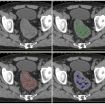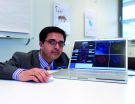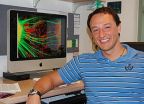(Press-News.org) Technology developed at the University of Sussex helps hospitals make earlier and more accurate treatment decisions and survival assessments for patients with bowel cancer.
Bowel cancer kills more than 16,000 people a year in the UK, making it the nation's second-most common cause of cancer death (after lung cancer).
A novel medical-imaging technology, TexRAD, which analyses the texture of tumours, has been shown in trials to enable early diagnosis of those bowel-cancer patients not responding to the standard cancer therapy better than other available tumour markers.
Furthermore, the TexRAD markers showed the ability to assess at an early stage the likelihood of survival, distinguishing patients who will have a good prognosis from those having poor prognosis.
Dr Balaji Ganeshan, one of the Sussex academics whose research led to the development of the technology, said: "By using TexRAD to scan for subtle anomalies in a tumour's texture, researchers have been able to spot more quickly when treatments are - or are not - working and adjust treatment accordingly.
"And because TexRAD simply provides an additional layer of software analysis of the MRI and CT scans that already exist as part of routine clinical practice, it is non-invasive from the patient's point of view and potentially cost-effective to the healthcare provider."
The technology is being evaluated in a number of prestigious research institutions and university hospitals around the world.
Across two separate UK studies, researchers analysed the tumours of 155 bowel-cancer patients.
In a study at University College London Hospitals, researchers analysed baseline PET-CT scans - ie those taken before treatment - and then followed up with the patients for an average of three years later. They found that analysing the texture of the tumours in the initial scans enabled them to accurately predict patient survival.
At Colchester General Hospital, the researchers looked at MR scans taken both before treatment and six weeks after the patients had completed chemotherapy and radiotherapy, and found that the patients whose tumours were less heterogeneous - ie more uniform - in terms of texture parameters six weeks after treatment were more likely to survive longer.
Meanwhile, researchers from the University of Rome found that texture analysis provides useful 'imaging biomarkers' that indicate how the tumour is responding to chemotherapy and radiotherapy. Professor Andrea Laghi, Professor of Radiology at the University of Rome and principal investigator of the study, said: "The identification of new, accurate imaging biomarkers such as TexRAD analysis of MR images for early assessment of first-line cancer therapy response (predominantly to shrink the tumour before the main treatment) could be helpful in refining bowel-cancer patient management, providing a better targeting of preoperative therapy."
The findings of the three studies will be presented to a wide international audience of clinicians (radiologists), imaging scientists, healthcare providers and industry at the 100th premier annual scientific meeting and exhibition of the Radiological Society of North America (RSNA), which takes place in Chicago from 30 November until 5 December.
INFORMATION:
Notes for editors
For press enquiries, contact the University of Sussex Press Office: James Hakner and Jacqui Bealing; press@sussex.ac.uk (+44)1273 678888.
TexRAD is attending the 100th scientific assembly and annual meeting of the Radiological Society of North America on 30 November to 5 December 2014 at the McCormick Place in Chicago, USA. The theme of the meeting is 'A century of transforming medicine'.
Based on the initial research by Sussex academics, TexRAD develops and markets a radical new imaging software that can extract vital additional information from routinely acquired whole-body diagnostic images of patients with cancer and other diseases and can assist clinicians in improved decision-making, i.e. prognosis, disease characterisation and response to treatment. It provides for the first time a commercially available imaging platform suite further developed under medical regulatory environment (for potential clinical use) dedicated for undertaking textural analysis of tumours.
TexRAD was originally a joint venture between the University of Sussex, Imaging Equipment Ltd, Cambridge Computed Imaging Ltd (CCI) and Miles Medical Pty Ltd, based on research by Professor Chris Chatwin, Dr Rupert Young and Dr Balaji Ganeshan from the Department of Engineering and Design at the University of Sussex and Brighton and Sussex Medical School (BSMS), and Professor Ken Miles (formerly BSMS). Dr Ganeshan is currently also a Senior Imaging Scientist at the University College London.
In May 2014, TexRAD Ltd along with Cambridge Computed Imaging was bought by Feedback plc, an AIM-listed company specialising in medical imaging tools.
Changes to China's drink driving laws are catching the community off guard with more than 70 per cent of people unaware of the blood alcohol limits that could see them face criminal charges, according to new Queensland University of Technology (QUT) research conducted in two Chinese cities.
QUT's Centre for Accident Research & Road Safety - Queensland (CARRS-Q) has partnered with organisations in China to promote road safety and reduce fatalities and injuries, as alcohol-related driving offences are being brought into sharper focus because of the country's rapid motorisation ...
A new climate change modeling tool developed by scientists at Indiana University, Princeton University and the National Oceanographic and Atmospheric Administration finds that carbon dioxide removal from the atmosphere owing to greater plant growth from rising CO2 levels will be partially offset by changes in the activity of soil microbes that derive their energy from plant root growth.
Soils hold more carbon than all of the earth's plant biomass and atmosphere combined. The new work published by Benjamin N. Sulman, a postdoctoral researcher in the lab of co-author and ...
INDIANAPOLIS -- A new treatment regimen for hepatitis C, the most common cause of liver cancer and transplantation, has produced results that will transform treatment protocols for transplant patients, according to research published online today in the New England Journal of Medicine.
The investigational three-drug regimen, which produced hepatitis C cure rates of 97 percent, is an oral interferon-free therapy. Previously, the typical treatment for hepatitis C after a liver transplant was an interferon-based therapy, usually given for 48 weeks. It had a much lower response ...
Lead researcher, Dr Sarah Dunstan from the Nossal Institute of Global Health at the University of Melbourne said the study is the first large-scale, unbiased search for human genes that affect a person's risk of typhoid.
Enteric fever, or typhoid fever as it more commonly known, is a considerable health burden to lower-income countries.
This finding is important because this natural resistance represents one of the largest human gene effects on an infectious disease.
"We screened the human genome to look for genes associated with susceptibility to, or resistance ...
Weeds in the UK are still evolving hundreds of years after their introduction and are unlikely to have yet reached their full potential as invaders, UNSW Australia scientists have discovered.
The study is the first to have tracked the physical evolution of introduced plant species from the beginning of their invasion to the present day, and was made possible by the centuries-old British tradition of storing plant specimens in herbaria.
The research team, led by Habacuc Flores-Moreno, looked at three common weeds - Oxford ragwort, winter speedwell and a willow herb - which ...
A controversial medication used by breastfeeding women should not be restricted because of the benefits it offers mothers and their babies, according to researchers at the University of Adelaide.
The medication domperidone has recently been the subject of warnings from the European Medicines Agency based on research that there is a link between the medication and fatal heart conditions.
Domperidone has been banned in the United States for years because of fatal cardiac arrhythmias among cancer patients who had been prescribed the drug to prevent nausea and vomiting.
However, ...
This news release is available in German. X-rays are widely used in medicine and in materials science. To take a picture of a broken bone, it is enough to create a continuous flux of X-ray photons, but in order to study time-dependent phenomena on very short timescales, short X-ray pulses are required. One possibility to create short hard X-ray pulses is hitting a metal target with laser pulses. The laser rips electrons out of the atoms and makes them emit X-ray radiation. Electrical engineers at the Vienna University of Technology (TU Wien) together with researchers ...
With the help of mouse models, induced pluripotent stem cells (iPSCs) and the "tooth fairy," researchers at the University of California, San Diego School of Medicine have implicated a new gene in idiopathic or non-syndromic autism. The gene is associated with Rett syndrome, a syndromic form of autism, suggesting that different types of autism spectrum disorder (ASD) may share similar molecular pathways.
The findings are published in the Nov. 11, 2014 online issue of Molecular Psychiatry.
"I see this research as an example of what can be done for cases of non-syndromic ...
An international research team led by Dan Distel, director of the Ocean Genome Legacy Center of New England Biolabs at Northeastern University, has discovered a novel digestive strategy in shipworms. The breakthrough, the researchers say, may also be a game-changer for the industrial production of clean biofuels.
To start, it's important to note that shipworms, the so-called "termites of the sea," aren't actually worms--they're bizarre clams that ...
WASHINGTON - Hospital workers who deal directly with patients wash their hands less frequently as their workday progresses, probably because the demands of the job deplete the mental reserves they need to follow rules, according to new research published by the American Psychological Association.
Researchers led by Hengchen Dai, a PhD candidate at the University of Pennsylvania, looked at three years of hand-washing data from 4,157 caregivers in 35 U.S. hospitals. They found that "hand-washing compliance rates" dropped by an average of 8.7 percentage points from the beginning ...







